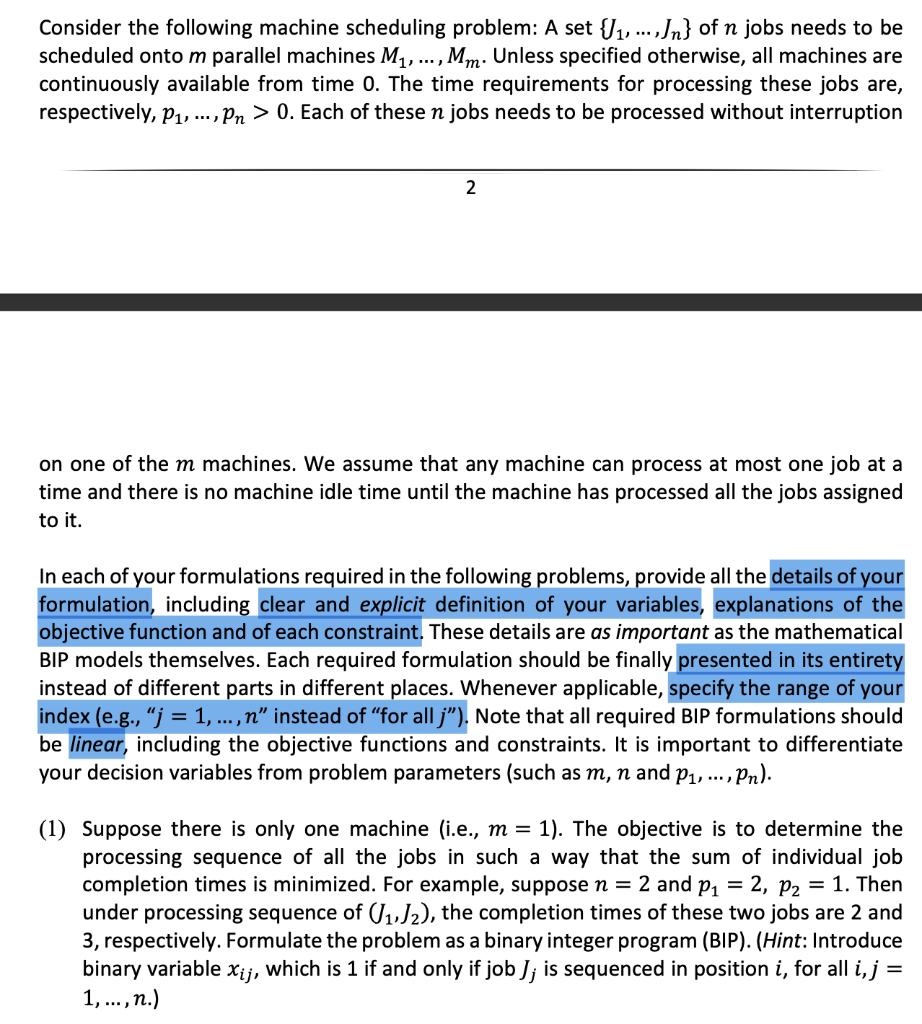Answered step by step
Verified Expert Solution
Question
1 Approved Answer
Please answer this carefully! Thank you! Consider the following machine scheduling problem: A set {I1, ...,Jn} of n jobs needs to be scheduled onto m

Please answer this carefully! Thank you!
Consider the following machine scheduling problem: A set {I1, ...,Jn} of n jobs needs to be scheduled onto m parallel machines M1, ..., Mm. Unless specified otherwise, all machines are continuously available from time 0. The time requirements for processing these jobs are, respectively, P.1, ..., Pn > 0. Each of these n jobs needs to be processed without interruption 2 on one of the m machines. We assume that any machine can process at most one job at a time and there is no machine idle time until the machine has processed all the jobs assigned to it. In each of your formulations required in the following problems, provide all the details of your formulation, including clear and explicit definition of your variables, explanations of the objective function and of each constraint. These details are as important as the mathematical BIP models themselves. Each required formulation should be finally presented in its entirety instead of different parts in different places. Whenever applicable, specify the range of your index (e.g., j = 1, ..., n" instead of "for all j"). Note that all required BIP formulations should be linear, including the objective functions and constraints. It is important to differentiate your decision variables from problem parameters (such as m, n and P1, ..., Pn). (1) Suppose there is only one machine (i.e., m = 1). The objective is to determine the processing sequence of all the jobs in such a way that the sum of individual job completion times is minimized. For example, suppose n = 2 and p1 = 2, P2 = 1. Then under processing sequence of (1J2), the completion times of these two jobs are 2 and 3, respectively. Formulate the problem as a binary integer program (BIP). (Hint: Introduce binary variable xij, which is 1 if and only if job ); is sequenced in position i, for all i, j = 1,..., n.) Consider the following machine scheduling problem: A set {I1, ...,Jn} of n jobs needs to be scheduled onto m parallel machines M1, ..., Mm. Unless specified otherwise, all machines are continuously available from time 0. The time requirements for processing these jobs are, respectively, P.1, ..., Pn > 0. Each of these n jobs needs to be processed without interruption 2 on one of the m machines. We assume that any machine can process at most one job at a time and there is no machine idle time until the machine has processed all the jobs assigned to it. In each of your formulations required in the following problems, provide all the details of your formulation, including clear and explicit definition of your variables, explanations of the objective function and of each constraint. These details are as important as the mathematical BIP models themselves. Each required formulation should be finally presented in its entirety instead of different parts in different places. Whenever applicable, specify the range of your index (e.g., j = 1, ..., n" instead of "for all j"). Note that all required BIP formulations should be linear, including the objective functions and constraints. It is important to differentiate your decision variables from problem parameters (such as m, n and P1, ..., Pn). (1) Suppose there is only one machine (i.e., m = 1). The objective is to determine the processing sequence of all the jobs in such a way that the sum of individual job completion times is minimized. For example, suppose n = 2 and p1 = 2, P2 = 1. Then under processing sequence of (1J2), the completion times of these two jobs are 2 and 3, respectively. Formulate the problem as a binary integer program (BIP). (Hint: Introduce binary variable xij, which is 1 if and only if job ); is sequenced in position i, for all i, j = 1,..., n.)Step by Step Solution
There are 3 Steps involved in it
Step: 1

Get Instant Access to Expert-Tailored Solutions
See step-by-step solutions with expert insights and AI powered tools for academic success
Step: 2

Step: 3

Ace Your Homework with AI
Get the answers you need in no time with our AI-driven, step-by-step assistance
Get Started


